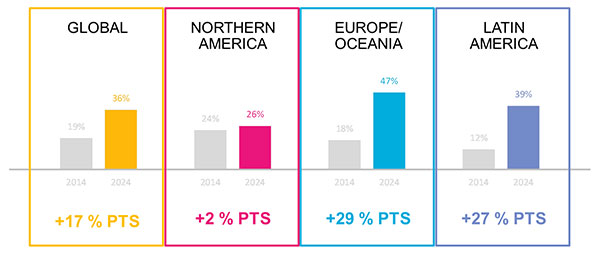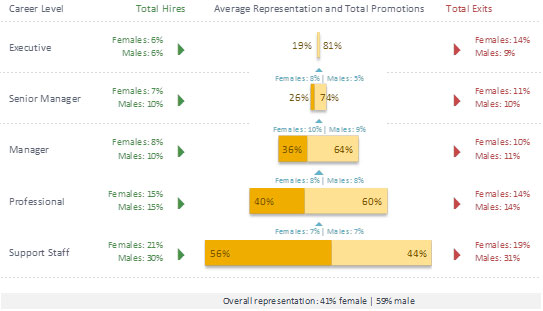Study: Efforts on Gender Diversity Not Improving Workforce Progression of Women
Women, who continue to be underrepresented at most levels in the workforce, are not progressing in their careers despite the past two decades of organizational efforts to achieve gender diversity and equality, according to new global research from Mercer, When Women Thrive, Businesses Thrive. Among survey participants, if current approaches continue unchanged, only one-third of executive positions will be held by women over the next 10 years. In the mature economies of the US and Canada, however, just one-fourth of women will hold executive positions by 2024, while female representation in developing countries is expected to grow more rapidly.
Figure 1: Summary of global workforce representation between 2014 and 2024

Source: Mercer’s When Women Thrive, Businesses Thrive research
“While the diversity efforts of the past several decades have resulted in some improvements in women’s participation rates and career trajectories, our research shows that we’re still decades away from true gender equality – if we keep doing what we’re doing,” said Pat Milligan, president of Mercer’s North America region. “It’s time to act differently to realize the benefit of their full participation and address the unique needs of female employees.”
According to Mercer’s research, which broadly assesses the impact of organizational practices and policies on the representation and advancement of women in the workforce, organizations are still far from achieving gender equality. Despite making up 41 per cent of the workforce globally, women’s highest representation among all career levels is in support staff roles. Women make up 40 per cent of the workforce at the professional level and 36 per cent at the managerial level, but only 26 per cent of senior managers and 19 per cent of executives.
Figure 2: Internal Labor Market Map (global, 124 organizations)*

Source: Mercer’s When Women Thrive, Businesses Thrive research
Key drivers of gender diversity
A key finding of Mercer’s research shows that the active involvement of senior leaders in gender diversity leads to greater, accelerated representation of women in executive roles more so than accountability alone. Yet, just more than half (56 per cent) of organizations indicate that their senior executives are actively involved in diversity and inclusion programs.
Furthermore, a dedicated team responsible for pay equity leads to more women in senior roles while common policies – those intended to ensure equity through flexible work schedules and leave programs – are, in the absence of management, associated with slower improvement in the number of women in leadership positions.
Mercer’s research also shows that non-traditional solutions to gender diversity positively impact an organization’s long-term ability to engage and retain female talent. For instance, more diverse retirement programs, including monitoring savings by gender, providing investment training customized to different gender realities, and gender-specific health education campaigns correlate with greater representation of women at senior levels. Yet, fewer than 15 per cent of organizations monitor savings and offer retirement programs customized to different gender behaviors.
Priorities vary by region
Women have higher representation in the US and Canada (48 per cent) and significantly lower in Europe/Oceania and Latin America (37 per cent and 33 per cent, respectively), organizations worldwide are far from achieving gender equality.
In terms of hiring, women in the US and Canada lag behind their male counterparts at every career level except the professional and executive levels, while women in Europe/Oceania lag behind in all but the manager level. Organizations in Latin America are the most aggressive in hiring women at entry-levels, but female hires begin to lag behind male hires above the manager level.
While current efforts to move more women into top roles over the next decade will impact representation of women in the future, it will vary greatly by region. In US and Canada, the number of women at the highest ranks is on track to remain essentially flat over the next 10 years, with 26 per cent of executive roles held by women in 2024 compared to 24 per cent today. However, organizations in Europe/Oceania could make substantial gains in gender equality at the top of the house over the next 10 years as organizations in this region are expected to increase the number of women in executive roles from 18 per cent to 47 per cent. Latin American organizations could also show significant growth in female representation at the executive level over the next decade with growth expected to advance from 12 per cent today to 39 per cent by 2024.
Importantly, how well organizations make use of female talent is a function of how well they attract, develop, and retain them. Mercer’s research indicates that organizations confident in their ability to attract, develop, and retain female talent – after considering the broad set of programs covered – have more favorable representation of women in senior positions in the long-term.
From a talent management perspective, optimal strategies vary across regions. In the US and Canada, companies should focus on improved equity in promotions since women are hired at lower rates. In Europe/Oceania, companies need to improve hiring of women. Organizations in Latin America should focus on retaining women at better rates. Consistent across all regions is the need to focus on retention of women in executive roles.
To learn more about the findings of this research, and download the full report, visit www.mercer.com.
* Mercer uses Internal Labor Market (ILM) maps and statistical modeling to diagnose issues related to talent flows inside organizations across hundreds of companies and industries. An ILM map, a graphical representation of the talent pipeline in an organization, summarizes for each standard career level, the rate at which talent is coming into the organization, moving up through the hierarchy, and exiting the workforce. When broken down by gender, an ILM reveals differences in the levels occupied by women and men as well as differences in talent flows (hires, promotions, and terminations) driven by an organization’s distinct employment experiences.








